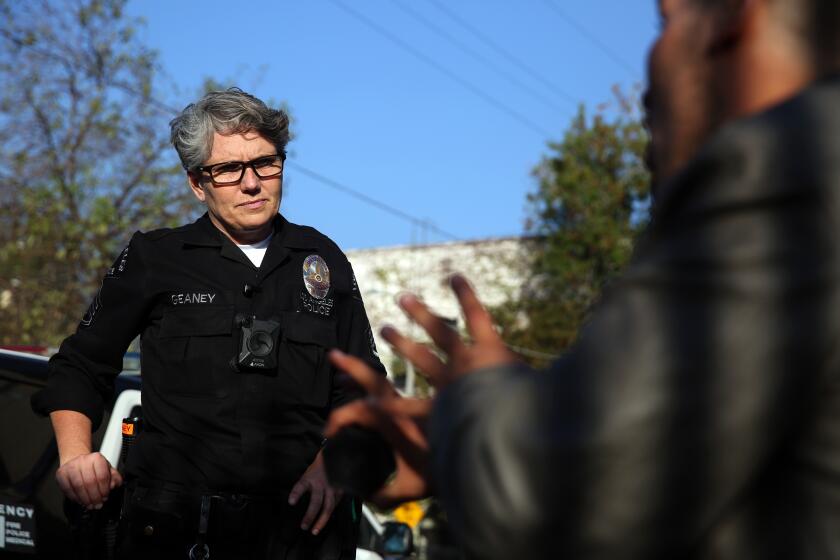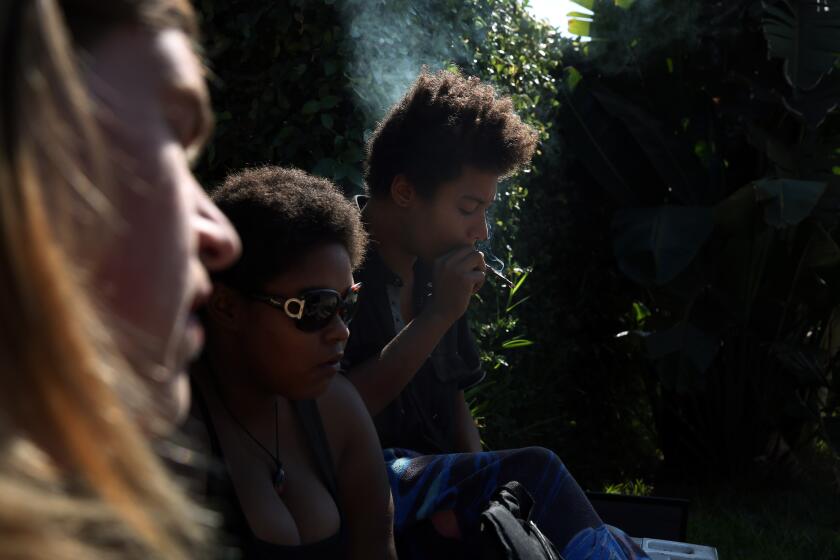Column: Young people come from around U.S. to live on Hollywood’s streets. How much more can we take?

Part Two: The homeless camp
One day on Carlos Avenue in Hollywood last month, just south of the 101 Freeway, I met a woman who goes by the name Raven. She said she was 29, had been homeless since she was 17, and headed west in June from her home in Ohio.
Why L.A.?
Why not?
Like so many others, in so many other places, Raven wanted a change. And for restless spirits, the West still beckons.
But she suffered from an autoimmune disorder and came to believe, shortly after arriving, that Los Angeles had nothing but crappy options for her.
“I could couch-surf and get raped,” Raven said.
Or she could get a job and hope she didn’t get sick and lose it, which had happened before. But even with a decent paycheck, Raven said, she couldn’t afford a place of her own. Not with these crazy prices. So instead she was reading tarot cards on Hollywood Boulevard when she could find a taker, and living in a tent on Carlos Avenue, “with typhus and rats and human [feces] everywhere.”
I told Raven I had met with frustrated, exasperated residents of the area who wanted their sidewalks back, and they too were tired of tiptoeing around human waste.
Raven’s jaw tightened and her eyes narrowed.
“Then why don’t they open some bathrooms?” she asked, anger rising. “We need housing, and we need some ... respect. People walk past us and make fun of us, and we’re more afraid of them than they are of us. How dare them!”
::
Hollywood has long had a dark underbelly. Maybe the darkness, rather than the glitz, was always the bigger draw. Maybe there were always more people running from something rather than to something. But I have never seen it as ruptured as it is now, with thriving commerce and astonishing social collapse side by side.
You see damage everywhere. You see the pain of abuse and neglect, you see the harrowing effects of mental illness, you see the way drugs can empty the eyes and anchor someone to the street, and you see a bit of the relief that comes from knowing you’re in a place, finally, where you don’t have to hide sexual or gender identity.
‘These are people whose back story is “my stepdad tried to kill me at 3; I was raped at 5; I was a prostitute at 14.” ’
— Amie Quigley, director of community services at First Presbyterian Church of Hollywood
The young people who go through the youth service center called My Friend’s Place are often wounded casualties of foster and juvenile justice experiences in L.A. and elsewhere, said program director Erin Casey. They don’t hit the streets for the meth, Casey said, but if they’re out there long, the powerful drug can help them temporarily “manage the trauma,” even as it slowly destroys them.
The downward spiral is hard to escape, but occasionally there are happy endings. On a visit to My Friend’s Place last week, I met a woman of 40 who had been a client there in her teens and later, amazingly, became a physician. Sheryl Recinos said she ended up homeless in Hollywood after running away to Los Angeles from a dysfunctional home in North Carolina and then getting raped after she arrived.
It took years for her to trust any adult, said Recinos — whose book on her journey is called “Hindsight: Coming of Age on the Streets of Hollywood” — and to believe that My Friend’s Place was really trying to help her. The young people on the streets of Hollywood today probably think they’re going to die young, Recinos said.
Understanding them isn’t possible without knowing that.
::
On Carlos Avenue, Raven’s friend Joe told me he came to Los Angeles not long ago, from Tennessee, looking for a woman he’d met on the internet. But like Hollywood itself, she was a tease, a dream. Joe said they never even met. He got booted from the bus station downtown for trying to catch a nap, then wandered over to Hollywood with little money and even less of a plan.
“I just want to get a legit job,” said Joe, who told me he had thought about going into comedy, or investing in bitcoin, or saving up enough to buy a vehicle he could live in.
In the meantime, he said, he digs for some of his meals out of trash containers.
“You just don’t dig to the bottom,” he said.
I asked Joe if he knew why more people don’t return home when they find out how hard it is to survive in L.A.
“A lot of them can’t go back home,” Joe said. “A lot of them have warrants.”
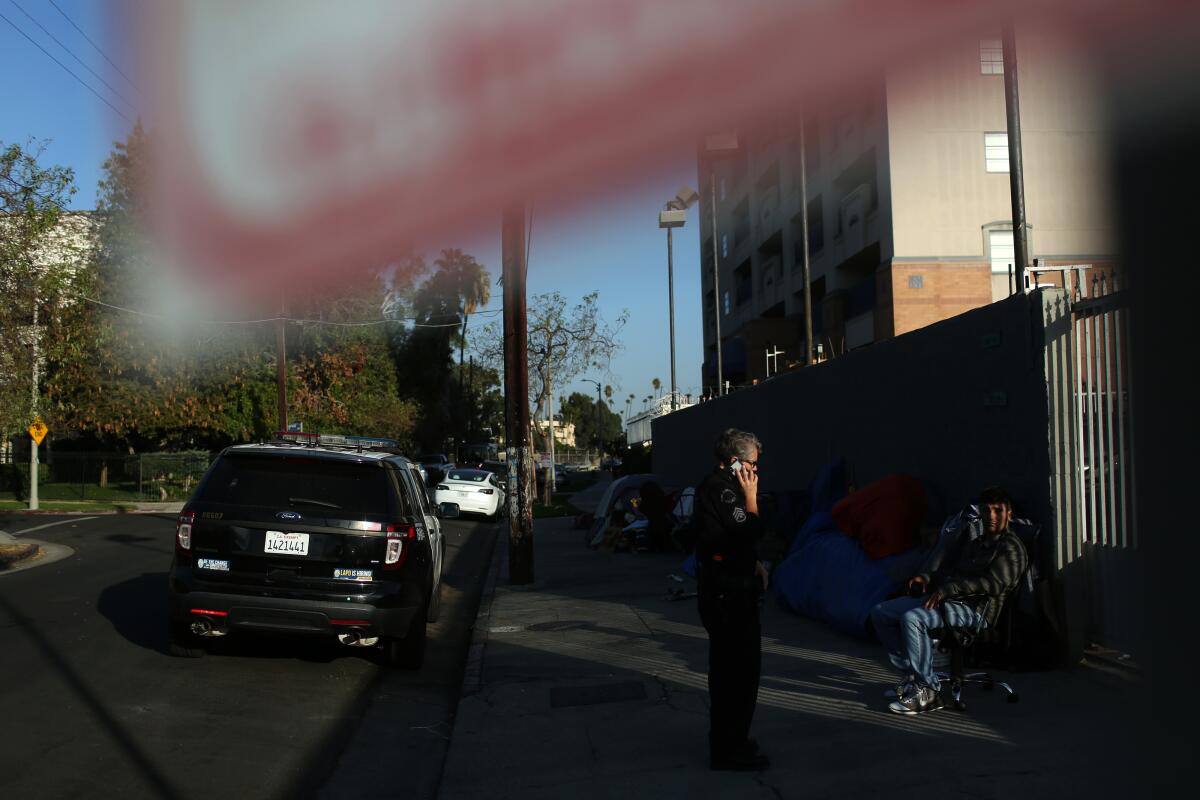
Outreach workers make the rounds in Hollywood, keeping tabs on the Ravens and the Joes, asking if they’re OK. One such worker was helping Joe get into L.A.’s homeless services system. Joe, born out of state, didn’t have a Social Security card or birth certificate, which would make it nearly impossible for him to get work or housing, but the outreach worker promised to help.
Well, I thought, it would be great if Joe made that tough transition from homeless to housed.
But I had another thought too:
How many Joes can Los Angeles take care of?
I’m not suggesting there shouldn’t be a net for those who stumble, get sick, or get chewed up by an economy that buries more people than it lifts.
But with nearly 60,000 homeless people in L.A. County and limited resources, should taxpayers who can barely cover their own cost of living be on the hook for every new arrival from somewhere else in California or the nation?
I’m not convinced we’re helping those who need it most. An average of about three homeless people die each day in L.A. County, while countless others suffer monstrous madness in full public view. I don’t think we’re working hard enough to reach the neediest.
“We’re not distinguishing,” said Kerry Morrison, who’s working on a pilot designed to bring better mental health treatment to Hollywood’s most severely disabled people. “You can come to California, sleep on the streets, do drugs — which are easy to find — and when you’re ready, you can get in line to get a housing voucher with no strings attached. And that is not sustainable.”
On the same street where I spoke to Raven and Joe, a young woman in a wheelchair spoke wistfully about her family in Idaho and about her child, who was in foster care. Another young woman, living in a tent, said she was pregnant, something that will probably move her up on the waiting list for housing.
A young chap who moved here from Oregon a couple of years ago to get away from his problems told me he had only found more. As we talked, he ran a finger along the bridge of his nose, wondering if it was broken. He said he’d been jumped twice the last couple of days.
An hour later, I saw some of the people I had talked to sitting in a circle on the pavement, passing a piece of aluminum foil and snorting a line of something.
Meth is everywhere. So is fentanyl. They are killing people.
In Hollywood, and in much of L.A. County, the housing shortage is only part of the problem.
::
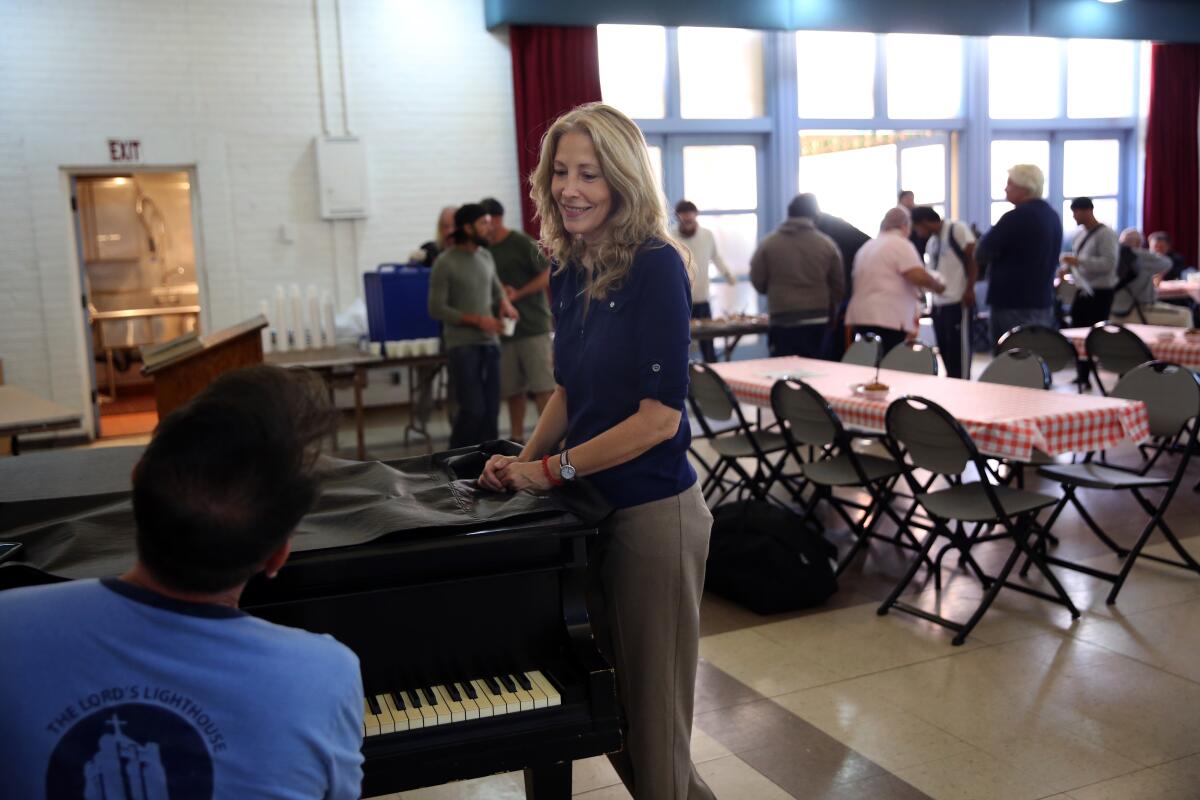
“One hundred percent of everybody out there has trauma,” said Amie Quigley, director of community services at First Presbyterian Church of Hollywood, which is surrounded by encampments and provides services to those with severe mental illness. “You don’t meet anyone who’s high-functioning but going through a tough time. … These are people whose back story is ‘my stepdad tried to kill me at 3; I was raped at 5; I was a prostitute at 14.’”
Quigley tries to “lovingly redirect” people, as she describes her mission, and sometimes that means sending them back where they came from. Quigley estimated that church staff had arranged for about 40 people to get on a bus and go back home so far this year. Typically, she said, she’ll be talking to someone who’s having a rough time in L.A., and she’ll ask if they’ve considered returning home. Then comes the question:
“Do you think I should?”
Quigley answers honestly:
“I would.”
Quigley said she won’t buy bus tickets for people unless she thinks it’s the best choice for them, and they make the decisions. She tries to make sure there’s someone on the other end who can give them a shot at building a better life. If all that checks, she might say:
“You need to be in the safest place you can be in right now, and this isn’t that. You need to get to where you can get the best care, and I don’t want to see you on the sidewalk here for three more years.”
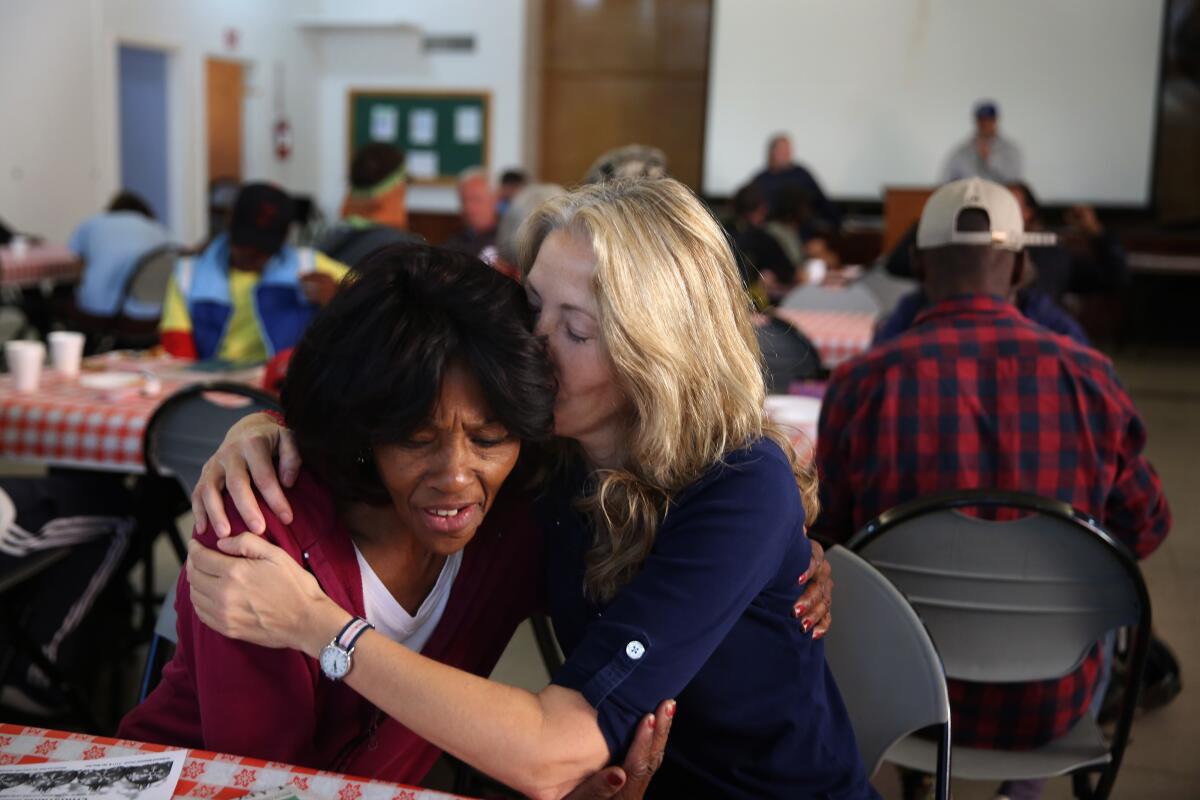
Quigley lives near the church, but said she no longer feels comfortable walking home through the Gower/101 underpass. From her office, she hears screaming from the tents, and the wailing of a dog that’s regularly beaten by a veteran with post-traumatic stress disorder.
“The domestic violence here is off the charts. We’re dealing with it in the tents, and I had to call the police because this guy was yelling at his wife that he was going to kill her, right outside my door. It was screaming you could hear in Pasadena,” Quigley said.
Quigley talks about the “competing virtues” of residents who want encampments cleared and homeless people who don’t want to be harassed and herded when there’s nowhere for them to go.
More from this Series
Maybe we need to regulate how long someone can stay in the same spot on the sidewalk, Quigley said, and maybe we need to bill other states for the services we provide their residents. A struggling but “semi-capable” person can be in L.A. a year or so, Quigley said, and get housing before a California native who’s schizophrenic and has been on the street for a decade.
“We have to look at who should be eligible for housing in Los Angeles, because it can’t be everyone having a tough time of it in Cincinnati,” Quigley said.
“We need new tactics.”
::

Alicia and her sister Tea, both 22, along with friends Gray and Keni, 20 and 23, used to live near the apartment building on Carlos Avenue where residents were begging for relief from the noise and the clutter.
Now they’re in shelters in Hollywood, matched for housing, and waiting for their new homes to become available. I found the four of them one day, sitting on the sidewalk across from the bridge shelter on Schrader Boulevard, passing a joint.
“Instead of coming out and talking to us as human beings, the first thing they did was jump to the police,” Alicia said when I told her about the fed-up residents.
She added that someone yelled at them out the window one day, calling them homeless bitches.
“It’s always rudeness before kindness,” she said, “but respect begets respect.”
She said if residents were complaining about their taxes paying for homeless services, she wasn’t losing any sleep.
“Youth have been screwed over by, sorry, your generation,” she said.
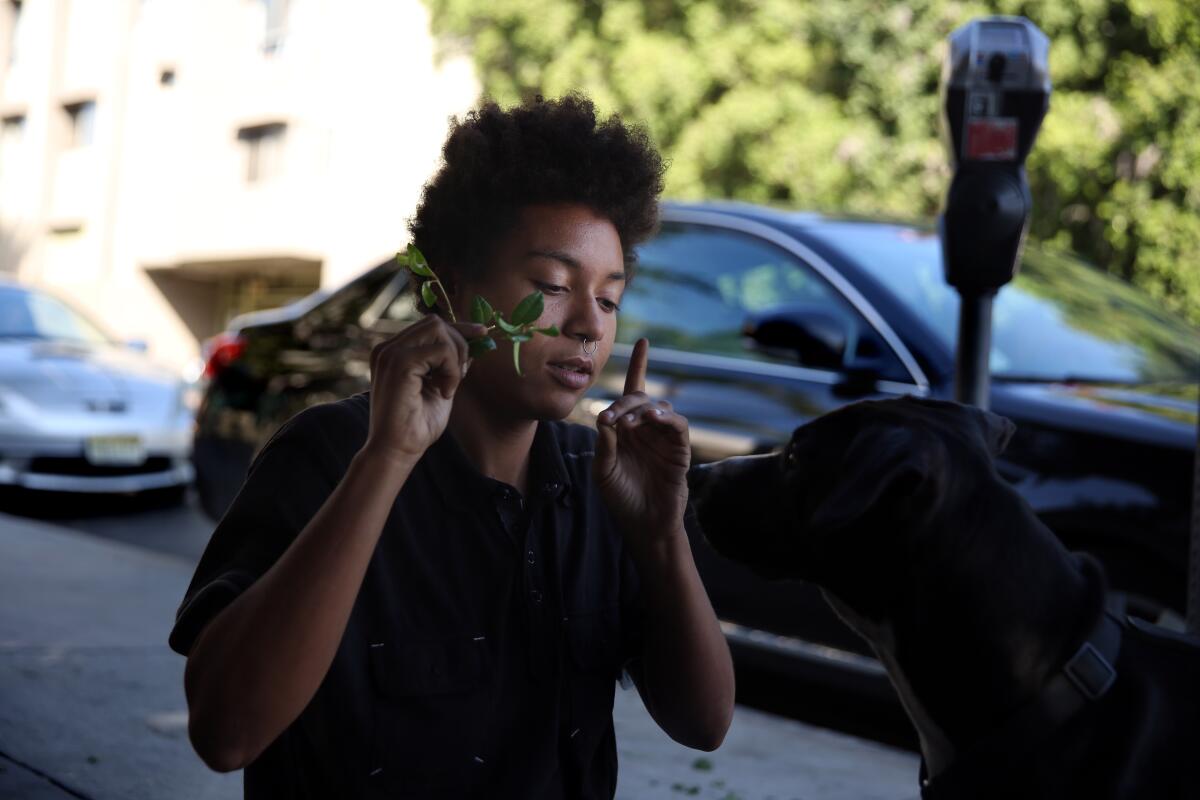
The four told me about their histories of broken homes and mental health evaluations. Gray is from Southern California, but Alicia, Tea and Keni are from Michigan. Alicia said she left after being raped there.
“It’s either be homeless in Michigan and choose to freeze to death or come here and live semi-comfortably until we get our s— together,” said Alicia, who told me she did her research on homelessness before heading west, considered Venice, but settled on Hollywood.
“I’d rather be in the inner city,” she said, “where there are more services.”
Hollywood has roughly 2,000 homeless people, and there are only 72 beds at the Schrader shelter. So she’s one of the lucky few, but I wonder if Schrader operates in a way that can really make a difference.
A former marine is now a cop, walking the streets of Hollywood on the homelessness beat. She sees a flawed strategy, haphazard execution and discouraging results.
Heidi Marston, chief program officer at the L.A. Homeless Services Authority, told me Schrader is still getting established but has had more early success than other shelters. When I asked how many people have moved on to permanent housing since the opening, the authority relayed numbers to me that it got from Mayor Eric Garcetti’s office.
Twenty-six people have been matched to housing; 16 more are ready to be matched when housing becomes available.
But only four have been housed so far.
In eight months.
And how many more homeless people have arrived in Hollywood in that time?
In Los Angeles, we all keep wondering when things are going to get better. But there’s no compelling reason to believe they won’t get worse.
More to Read
Start your day right
Sign up for Essential California for news, features and recommendations from the L.A. Times and beyond in your inbox six days a week.
You may occasionally receive promotional content from the Los Angeles Times.

